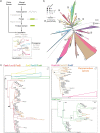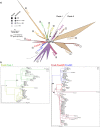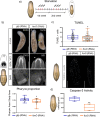Analysis of Fox genes in Schmidtea mediterranea reveals new families and a conserved role of Smed-foxO in controlling cell death
- PMID: 33536473
- PMCID: PMC7859237
- DOI: 10.1038/s41598-020-80627-0
Analysis of Fox genes in Schmidtea mediterranea reveals new families and a conserved role of Smed-foxO in controlling cell death
Abstract
The forkhead box (Fox) genes encode transcription factors that control several key aspects of development. Present in the ancestor of all eukaryotes, Fox genes underwent several duplications followed by loss and diversification events that gave rise to the current 25 families. However, few Fox members have been identified from the Lophotrochozoa clade, and specifically from planarians, which are a unique model for understanding development, due to the striking plasticity of the adult. The aim of this study was to identify and perform evolutionary and functional studies of the Fox genes of lophotrochozoan species and, specifically, of the planarian Schmidtea mediterranea. Generating a pipeline for identifying Forkhead domains and using phylogenetics allowed us the phylogenetic reconstruction of Fox genes. We corrected the annotation for misannotated genes and uncovered a new family, the QD, present in all metazoans. According to the new phylogeny, the 27 Fox genes found in Schmidtea mediterranea were classified into 12 families. In Platyhelminthes, family losses were accompanied by extensive gene diversification and the appearance of specific families, the A(P) and N(P). Among the newly identified planarian Fox genes, we found a single copy of foxO, which shows an evolutionary conserved role in controlling cell death.
Conflict of interest statement
The authors declare no competing interests.
Figures







Similar articles
-
Cell Death Regulation by Smed-foxO in the Planarian Schmidtea mediterranea.Methods Mol Biol. 2025;2871:179-191. doi: 10.1007/978-1-0716-4217-7_17. Methods Mol Biol. 2025. PMID: 39565589
-
Comparative transcriptomic analyses and single-cell RNA sequencing of the freshwater planarian Schmidtea mediterranea identify major cell types and pathway conservation.Genome Biol. 2018 Aug 24;19(1):124. doi: 10.1186/s13059-018-1498-x. Genome Biol. 2018. PMID: 30143032 Free PMC article.
-
Genetic expansion of chaperonin-containing TCP-1 (CCT/TRiC) complex subunits yields testis-specific isoforms required for spermatogenesis in planarian flatworms.Mol Reprod Dev. 2017 Dec;84(12):1271-1284. doi: 10.1002/mrd.22925. Epub 2017 Nov 10. Mol Reprod Dev. 2017. PMID: 29095551 Free PMC article.
-
Lophotrochozoan Zic Genes.Adv Exp Med Biol. 2018;1046:69-86. doi: 10.1007/978-981-10-7311-3_5. Adv Exp Med Biol. 2018. PMID: 29442318 Review.
-
[Regeneration of planarians: experimental object].Ontogenez. 2015 Jan-Feb;46(1):3-12. Ontogenez. 2015. PMID: 25898529 Review. Russian.
Cited by
-
Evidence for Multiple Independent Expansions of Fox Gene Families Within Flatworms.J Mol Evol. 2025 Feb;93(1):124-135. doi: 10.1007/s00239-024-10226-4. Epub 2025 Jan 18. J Mol Evol. 2025. PMID: 39825915
-
Evolutionary History of Bilaterian FoxP Genes: Complex Ancestral Functions and Evolutionary Changes Spanning 2R-WGD in the Vertebrate Lineage.Mol Biol Evol. 2025 Apr 1;42(4):msaf072. doi: 10.1093/molbev/msaf072. Mol Biol Evol. 2025. PMID: 40155202 Free PMC article.
-
Cell Death Regulation by Smed-foxO in the Planarian Schmidtea mediterranea.Methods Mol Biol. 2025;2871:179-191. doi: 10.1007/978-1-0716-4217-7_17. Methods Mol Biol. 2025. PMID: 39565589
-
FoxK1 is Required for Ectodermal Cell Differentiation During Planarian Regeneration.Front Cell Dev Biol. 2022 Feb 22;10:808045. doi: 10.3389/fcell.2022.808045. eCollection 2022. Front Cell Dev Biol. 2022. PMID: 35273960 Free PMC article.
-
A comprehensive study of arthropod and onychophoran Fox gene expression patterns.PLoS One. 2022 Jul 8;17(7):e0270790. doi: 10.1371/journal.pone.0270790. eCollection 2022. PLoS One. 2022. PMID: 35802758 Free PMC article.
References
Publication types
MeSH terms
Substances
LinkOut - more resources
Full Text Sources
Other Literature Sources
Miscellaneous

